Finally, a decent spell between rain periods. This was our first real shot at a few of the upper Hunter bass we'd been dreaming about. Good mate Paul Miranda joined me as we headed out for an overnight fish but on arrival we were greeted with swiftly flowing, discoloured water.
It wasn’t the best start but we were determined to wet a line and soon had the kayaks off the roof rack and on the water.
Fishing is one of those sports when you sometimes get a gut feeling you are in for something either very exciting or simply horrid. On this occasion it was the latter.
We'd thoroughly worked two great-looking pools and not had so much as a touch. Paul also looked a little despondent but we'd driven a fair way and weren't about to head straight home without giving it a decent shot. A slight change of plan was definitely in order.
After working the next slow moving pool for nothing, we decided to put in a decent effort right where the swift flowing water entered at the head of the pool.
We both tied on spinnerbaits and slowly dredged the headwaters and it took around four casts before Paul was on. It was no monster but a bass nonetheless to break the duck and give us a much-needed confidence boost.
We ended up pulling three fish from the head of the pool and were keen to work over the next swirling headwater.
Then Paul suggested we try the fast flowing runs between the pools. These were unfishable from the kayaks so we dragged them up on the bank and flicked lures as we walked.
We weren't just randomly casting anywhere, we started looking for any prominent back eddies and pockets of slower flowing water.
Because the water was up a few feet, the likely eddies were up tight against the newly covered ground.
The first promising spot was at the back of a large fallen log, which a few weeks back would have been high and dry. I cast a small fizzer into the pocket behind it and was belted straight away by a nice bass around 700g. You beauty! And good thinking, Paul!
We concentrated our efforts at the heads of the pools and on the swift runs and ended up with a respectable bag of fish.
While we certainly would have caught more bass under ‘normal’ conditions with the river running nice and clean, we felt pretty pleased with our efforts and worked out a few new tricks next time we fished swollen rivers.
After a prolonged dry spell, the first push of new water can really make fishing tough. The biggest problem isn't that the fish don't like the new faster water, it’s the sudden change of temperature.
Cool rainwater – barely 16° – sweeping down a river system that's up around 26° during the warmer months is guaranteed to send any bass into shutdown mode.
Usually no matter how hard you try during those first few days of rising water you'll struggle to get a fish.
But if you wait a tad longer and give the bass time to get used to the cooler water, you can expect to find fish again – though certainly not in huge numbers.
I've found it takes around a week or so before the fish have acclimatised and are hungry enough to deal with the water change.
Once they're used to the change you can expect pretty normal fishing, though you will most likely be dealing with higher than normal water and fish in more unusual places.
Bear in mind we're not talking about raging flood conditions, just higher than normal river heights and brown water.
Under proper flood conditions bass fishing is something you don't even think about doing. All those lovely, slow-flowing pools will be sweeping along at a frightening pace with logs, cows and other goodies in the mix.
The ‘shallow runs’ will be suitable only for daredevil whitewater rafters with a death wish.
While a major flood spells total disaster for any upcoming bass trip, they do have some positive spin-offs that will benefit anglers once things settle again.
The force of a flood, ripping down trees, eroding earth banks, gouging out new holes and laying up new sandbars, can rearrange whole river valleys. And it can deposit many snags from far away to become the new homes of bass in the good times to come.
After long periods of drought, weed growth can get totally out of control.
Weed beds are definitely great places to fish but when your favourite bass pools are choked from one side to the other, you will appreciate a good fresh to mow them back to a fishable level.
Floods also spread bass around into new country and at times put fish in some very unlikely places.
There's some great bass water I've been fishing lately just behind a coastal sand dune. In fact, one side of the lagoon is actually pure beach sand.
This odd 500m pocket of water is nowhere near the closest bass river, but thanks to coastal heathland becoming a brown inland sea during the last big flood, there's a great land-locked bass fishery totally unknown the masses.
Bass also use floods as an opportunity to migrate upstream or down, depending on whether they’re driven by the hunt for new water or the instinct to breed.
An Autumn/Winter flood offers bass a free ride to their brackish spawning grounds, while Spring or Summer rains give opportunities to head upstream into newly flooded billabongs, swamps and waterholes or the deeper holes in otherwise shallow creeks.
Big floods can put bass into some petty crazy places. I heard of one solid bass around 1.4kg being found in a windmill-filled horse trough out in the middle of a paddock after a big flood. Half a metre above dry ground and 3km from the nearest river system is a pretty odd place indeed to find a bass!
As touched on, one of the best places to find fish is in those swirling headwaters of each pool and the back eddies and pockets of slower moving water in the swift runs.
But the best approach is simply to head way up-river.
It took Paul and me a few years to work out that the further you head up river during periods of high water, the better your results will be.
There's nothing too scientific about it, it's simply a case of the headwater geography usually being stonier with fewer farms.
Rocky country equals less soil runoff, so even while often flowing quite swiftly, it will usually be much clearer and often slightly warmer.
The junctions of tributaries also provide good sport as the bass tend to exploit the differing clarities, temperatures and flows of the merging waters.
One flow or the other will be warmer, clearer, faster or contain more food; it’s just a matter of working out which is more suitable to the bass.
As the water starts to drop, things will rapidly begin to return to normal.
Bass again will hold station and be happy to feed along the edges of the long, slow moving pools.
The water will still most likely be discoloured in the mid to lower reaches but that's fine because the bass would have been hunting happily in dirty water for the past few weeks and will have little trouble finding your lures.
A good tip, though, is still to use quite bright subsurface lures with noisy rattles, or aggressive blades that send out plenty of distress signals.
As you can imagine, noisy surface lures are also a good choice. Worked very slowly and with boisterous, short, bumps and stabs, fizzers and poppers can tempt plenty of brown water bass.
Those keen on impoundment bass will find the rapid rise, new high water and eventually the settling period after heavy rain no less critical than those fishing the river systems. Impoundment bass are still bass and will definitely be found in different locations and behave differently under such conditions.
One of the best places after a period of heavy rain is the top end of the dam where the natural river system is flooding in.
Assuming the water isn't overly cool, you can expect bass to be just out of the current looking for food items pushing into the dam. Again, any back eddies, fallen logs and weedy points copping the new flow will be well worth a look.
Fishing the edges of a dam is fairly standard practice and during rising conditions the edge bite can be even more exciting.
Any newly flooded country will be worth a look, especially if there are water birds or other signs of life up on the flat country.
The weed beds so in favour at lower dam levels might initially be well under water but there’ll be plenty of fish foraging through flooded tussocks for insects and grubs or working along newly collapsed banks for earthworms and insect larvae.
While fishing for bass during periods of brown water isn't ideal, you can still reasonably expect to find numbers of fish if you put in a little effort.
It's largely a matter of looking for areas of warmer (and ideally slightly cleaner) water and fishing the slower moving zones within the faster sections.
Anywhere you would imagine an ambush predator to be successful in the prevailing conditions is likely to prove worthy of a cast.
Reads: 2475
Bibbed minnows with noisy rattles are good options when fishing brown water, although weed can become a real problem.
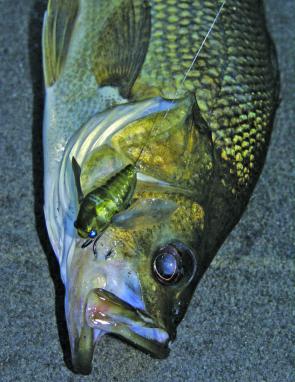
In swollen water noisy paddlers, like this Grand Siglett, are great for getting the attention of any nearby bass.
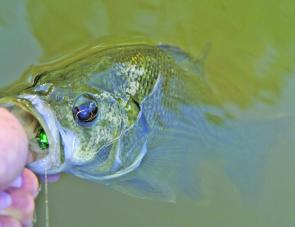
This bass had no problems finding a small surface lure in the turbid brown water.
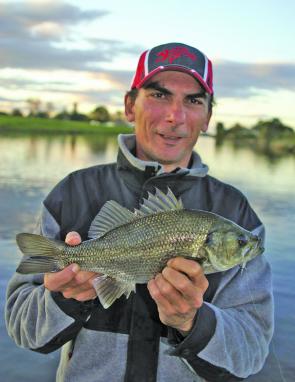
An early start put Jamie Robley onto this healthy big river bass. You'll often find slower moving water by fishing the larger, open sections of a river, though the water will often be browner in the lower sections.
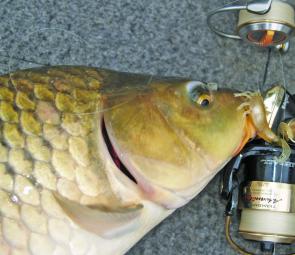
Dirty water means nothing to pests like this carp. A heavily scented soft plastic drifted around a flow-blocking point was a good idea but brought out the wrong fish.

As the water drops again, it exposes muddy banks and the edge bite fades away. Look for deeper snags and holes but don’t discount the middle of the river as the flow eases off – the current continues to bring down all sorts of debris.
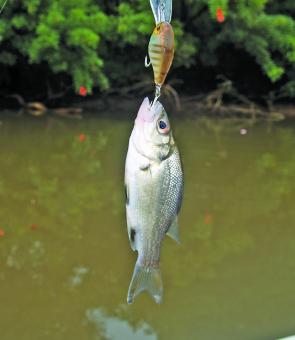
This tiny bass came from water the colour of chocolate milk. Bass are happy to feed in the brown stuff, though you do need to rethink where and how you fish.
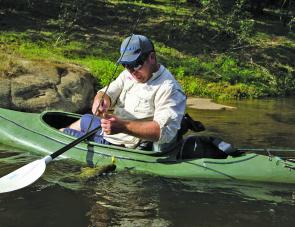
By heading way up-river you can often find clearer water. This solid bass came from the upper reaches of the Clarence River.
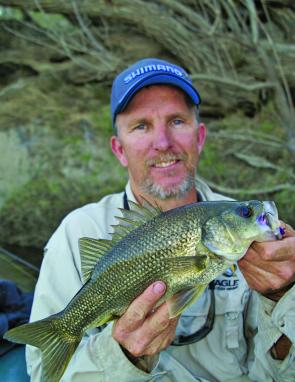
Slow moving jigs crawled across the bottom can tempt brown water bass checking out newly covered country. The keys are working the lure very slowly.




